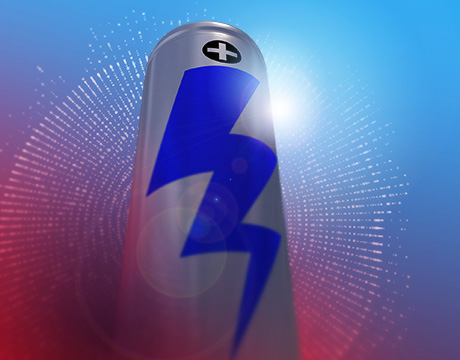Battery Capacity Gets a Boost
Battery Capacity Gets a Boost


Lithium ion is today’s go-to battery technology, but storage and safety are far from ideal. Improving these cells’ electrodes could make next-generation batteries both more powerful and less flammable.
A battery’s negative electrode, its anode, is only as good as the number of lithium ions it can share. That is why Erik Herbert of Michigan Technological University in Houghton, wants to make anodes from metallic lithium, the densest source of lithium ions available.
To do that, Herbert and his colleagues need to understand lithium’s behavior. Yet lithium’s high reactivity, which makes it a prized material for batteries, also makes it hard to measure. “Looking at high-purity lithium films requires having a really well-controlled environment,” Herbert said.
He was drawn to this project by an issue that plagues all lithium-ion batteries: Repeated charging cycles generate pressure that causes lithium to grow tiny fingers called dendrites. They can push through even harder solid ceramic electrolyte that separates one electrode from another—and short circuit the battery.
For You: Capturing and Reusing Wasted Energy with Nanopeapods
To understand dendrite growth, Herbert needed to measure the pressure response of microns-thick lithium samples. First, his colleagues at Oak Ridge National Laboratory lay down lithium under an ultrahigh vacuum. This yielded samples comparable to lithium electrodes in thin-film batteries.
Those samples arrive in Michigan under argon, where Herbert slices them for testing with tools originally meant for cutting stained glass. Then his team tests them with a nanoindenter and an optical microscope inside a glovebox that controls atmospheric oxygen and water.
The glovebox suppresses lithium’s propensity to react with air. Even so, the group has to perform its tests within a week or two to ensure the nanoindenter sinks into pure lithium rather than lithium hydroxide or lithium carbonate. After hundreds of load-response experiments, Herbert and his team have a hypothesis that explains how dendrites penetrate harder electrolytes. It turns out that lithium is much stronger at smaller scales. As a battery charges, pressure builds quickly in a tiny dendrite, and it forces its way into any defects in the hard electrolyte.
Not many people have focused on lithium’s fundamental properties this way. “Mechanical behavior is going to be somewhere near the bottom of the list when you think about factors that are really mission-critical in determining device performance,” said Herbert. He and his colleagues, however, have evidence that mechanical properties play an important role in battery reliability.
Next, Herbert and his team will look into the behavior of solid electrolytes and how lithium responds when attached to different electrolyte materials.
Menaka Wilhelm is an independent technology writer.
Read More:
Record Efficiency Highs on Solar
Beer Could Make Better Fuel than Ethanol
The Great Ocean Cleanup Begins






